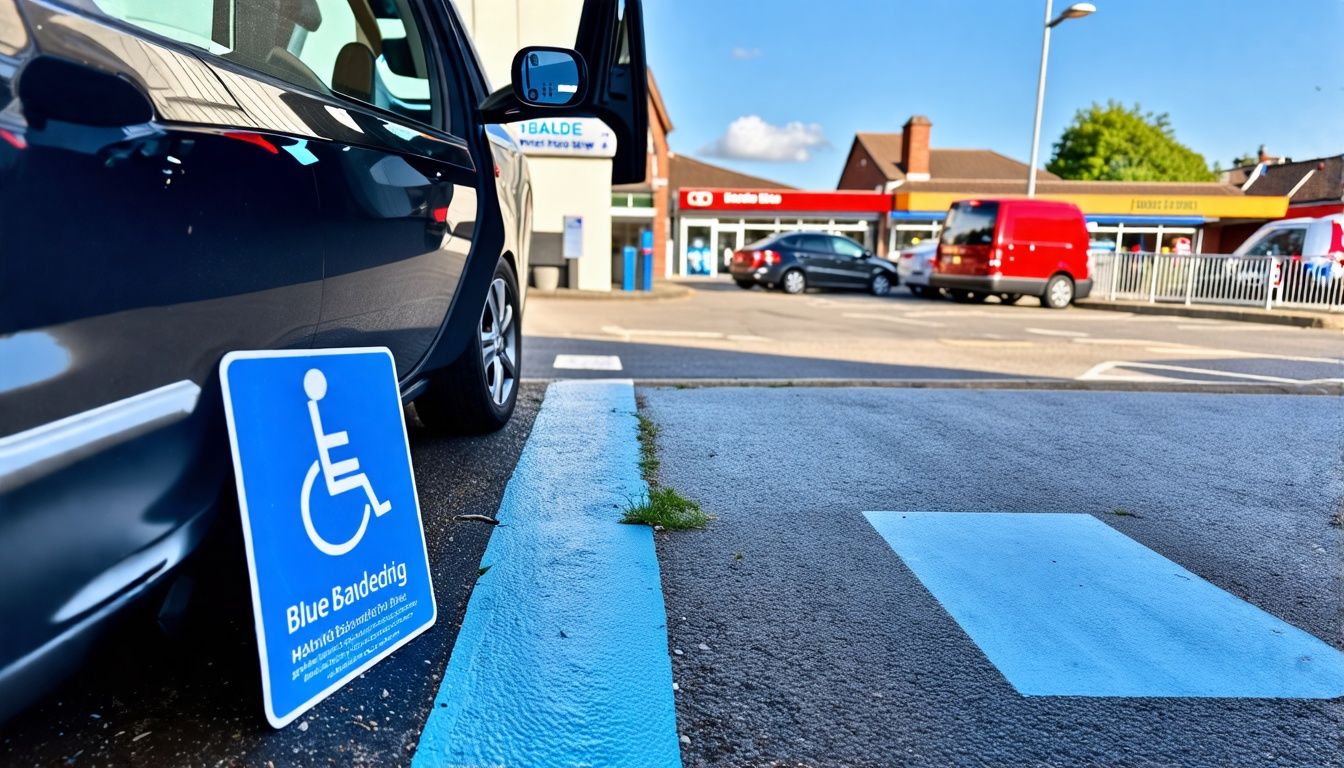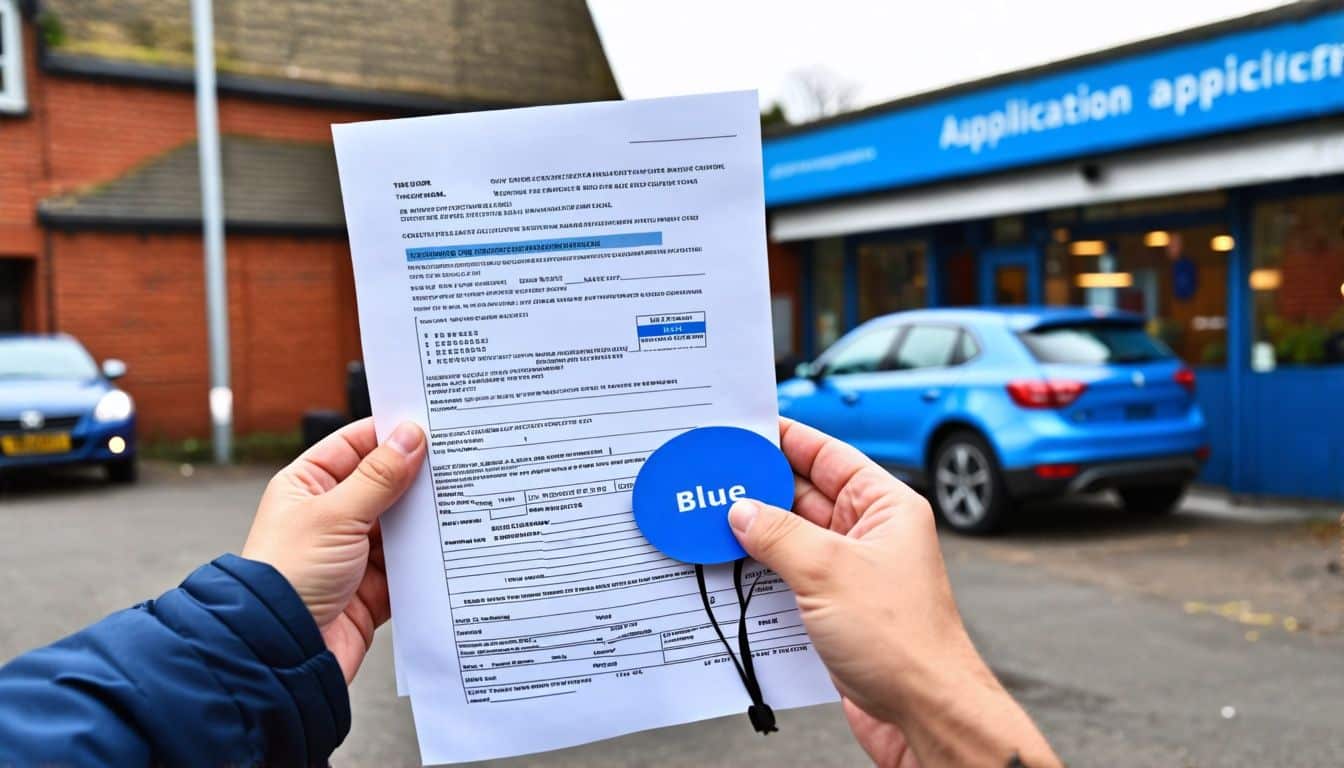Eligibility Criteria For Blue Badge In The UK
Struggling to understand if you qualify for a Blue Badge in the UK? Many people find the eligibility criteria confusing. The Blue Badge scheme helps those with disabilities or health conditions park more easily.
This article will explain the eligibility rules and guide you through the application process. Ready to learn more?
What is a Blue Badge?

A Blue Badge is a vital tool for people with disabilities or health conditions in the UK. It allows holders to park closer to their destinations, often in restricted areas. The badge provides exemption from certain parking restrictions and access to designated spaces.
This scheme aims to improve mobility and independence for those with enduring and substantial disabilities.
Blue Badges are valid for up to three years. They’re available to individuals and organisations meeting specific eligibility criteria. The badge helps those with visible and non-visible disabilities, including conditions like Parkinson’s, multiple sclerosis, and severe anxiety.
It’s crucial for those with limited mobility to access essential services and maintain their quality of life. Now, let’s explore the eligibility criteria for obtaining a Blue Badge.
Eligibility Criteria for a Blue Badge
The Blue Badge scheme helps people with disabilities park closer to their destination. You might qualify for a Blue Badge if you meet certain criteria.
Automatic qualification
Automatic qualification for a Blue Badge applies to specific groups. People aged three or over who receive certain benefits qualify without further assessment. These benefits include the higher rate mobility component of Disability Living Allowance.
Personal Independence Payment recipients scoring 8 points or more in the ‘moving around’ activity also qualify automatically.
Individuals with severe disabilities affecting both arms can get a Blue Badge without extra checks. Those registered blind or receiving a War Pensioner’s Mobility Supplement are eligible too.
Terminal illness patients with a DS1500 form qualify automatically. This streamlined process helps those with clear, severe mobility issues access parking benefits quickly.
Other qualifications
Blue Badge eligibility extends beyond automatic qualification. Individuals with substantial mobility issues or those who can’t walk more than 50 metres may qualify. This includes people with hidden disabilities like autism, dementia, or mental health conditions that affect their ability to travel.
The scheme also considers those who face risks to themselves or others when walking.
Applicants must provide evidence of their condition from a healthcare professional. This could be a GP, physiotherapist, or occupational therapist. The assessment focuses on how the disability affects daily life and mobility.
Each case is reviewed individually, ensuring fair consideration for all applicants.
Non-visible (hidden) disabilities
Non-visible disabilities now qualify for Blue Badge eligibility in the UK. This includes conditions like autism, mental health issues, and cognitive impairments. Applicants must prove their hidden disability significantly affects their mobility.
Evidence from medical professionals or specialists is crucial for the application process.
Individuals with non-visible conditions may face unique challenges when accessing parking. For instance, someone with agoraphobia might struggle to walk long distances in unfamiliar areas.
The Blue Badge scheme recognises these difficulties, offering support to those with hidden disabilities. This change has made the programme more inclusive, helping a wider range of people with mobility issues.
Children under 3
Children under 3 may qualify for a Blue Badge in specific cases. Parents or guardians must prove their child’s condition requires bulky medical equipment. This equipment should be difficult to carry around without close vehicle access.
Alternatively, the child’s condition might necessitate staying near a vehicle for treatment. The minimum age for automatic qualification has recently changed from 2 to 3 years old.
Applying for a Blue Badge for a young child involves a thorough process. Parents must provide medical evidence of the child’s condition and its impact on mobility. The local council assesses each application individually.
They consider the child’s needs and how a Blue Badge would benefit their care. The next section will explain how to apply for a Blue Badge, including the required documents and application process.
Applying for an organisational Blue Badge
Organisations can apply for a Blue Badge if they care for and transport people with disabilities. This includes care homes, hospices, and local authorities. The badge allows the organisation to park in designated spaces when transporting eligible individuals.
To qualify, the organisation must prove they regularly transport people who would be eligible for a Blue Badge themselves.
The application process for an organisational Blue Badge differs slightly from individual applications. Organisations must provide details about their services and the people they transport.
They also need to submit proof of their status as a care provider. The local council reviews these applications carefully to ensure the badge will be used appropriately. Once approved, the organisation can use the Blue Badge when transporting eligible individuals to various locations.
Now, let’s explore how to apply for a Blue Badge, including the documents required and the application process.
How to Apply for a Blue Badge
Applying for a Blue Badge is straightforward. You can do it online or by post through your local council.
Documents required
Applying for a Blue Badge requires specific documentation to prove eligibility. Here’s a list of documents you may need to provide:
- Proof of identity: A valid driving licence or passport.
- Proof of address: A recent utility bill or council tax statement.
- Proof of benefits: Letters showing receipt of Personal Independence Payment or other disability-related benefits.
- Medical evidence: A doctor’s letter or diagnosis for conditions like Alzheimer’s disease or chronic obstructive pulmonary disease (COPD).
- Photograph: A recent colour passport-style photo.
- Vehicle registration: If applying for an organisational Blue Badge.
- Evidence of non-visible disabilities: Medical reports or assessments for conditions causing psychological distress or mental health problems.
- Proof of terminal illness: A DS1500 form or letter from a healthcare professional.
- Birth certificate: For applications on behalf of children under 3 years old.
- National Insurance number: To verify identity and benefit claims.
- Payment details: A credit card for the application fee, where applicable.
Application process
Once you’ve gathered all necessary documents, the application process begins. The UK government has streamlined this procedure to make it as straightforward as possible.
- Visit your local council’s website or the GOV.UK Blue Badge portal to start your application.
- Fill in the online form with your personal details, including name, address, and National Insurance number.
- Provide information about your disability or health condition that affects your mobility.
- Upload digital copies of your supporting documents, such as proof of identity and evidence of your eligibility.
- Pay the application fee, which varies by council but is typically around £10.
- Submit your application and wait for the council to review it.
- Expect a decision within 12 weeks, though many councils process applications faster.
- If approved, your Blue Badge will be sent to you by post.
- The badge is valid for up to three years, after which you’ll need to renew it.
- Keep track of your badge’s expiry date to ensure continuous access to parking benefits.
Online Application Guide
After completing the application process, you’ll need to navigate the online system. The online application guide simplifies the Blue Badge application procedure, making it accessible for all eligible individuals.
- Log onto the official Blue Badge website using a computer or mobile device.
- Create an account or sign in if you already have one.
- Fill in personal details, including name, address, and National Insurance number.
- Select the reason for application, such as receiving Personal Independence Payments or having a hidden disability.
- Upload required documents, like proof of identity or medical evidence.
- Answer questions about your mobility and daily activities truthfully.
- Pay the application fee, which varies by local council.
- Submit the application and note down the reference number.
- Use assistive technology or screen readers if needed for accessibility.
- Check your email for confirmation and further instructions.
- Track your application status online using your reference number.
- Respond promptly to any requests for additional information.
Renewal process
Once you’ve completed your online application, it’s important to know about the renewal process. Blue Badges are typically valid for three years, so you’ll need to renew before it expires.
Here’s what you need to know about renewing your Blue Badge:
- Timing: Start your renewal application about 8 weeks before your current badge expires. This allows ample time for processing.
- Eligibility check: You’ll need to prove your eligibility again, even if you qualified automatically before. Your medical condition or disability may have changed.
- Required documents: Gather updated proof of identity, address, and disability. This might include recent medical reports or benefit award letters.
- Online renewal: Most local councils offer an online renewal service. It’s often quicker and easier than paper applications.
- Photo update: You’ll need to provide a new passport-style photograph. Ensure it meets the specified requirements.
- Payment: There’s usually a fee for renewing your Blue Badge. The amount varies by council, but it’s typically around £10.
- Processing time: Renewal applications can take up to 12 weeks to process. Apply early to avoid a gap in your Blue Badge coverage.
- Temporary badge: If your current badge expires during the renewal process, some councils may issue a temporary badge.
- Changes in circumstances: Report any changes in your condition or personal details. This could affect your eligibility.
- Organisational badges: If you’re renewing for an organisation, you’ll need to provide updated information about the vehicles and users.
Conclusion
The Blue Badge scheme offers vital support for those with disabilities. It provides easier parking and improved access to essential services. Eligibility criteria ensure the badges reach those who need them most.
Applicants should carefully review the requirements before applying. Remember, the scheme aims to enhance mobility and independence for individuals with enduring disabilities.
FAQs
1. Who can apply for a Blue Badge in the UK?
People with mental health disorders, terminal illnesses, or mobility issues may qualify. This includes those with motor neurone disease or heart failure causing severe breathlessness.
2. How does a Blue Badge help with parking?
A Blue Badge allows holders to park in disabled bays and near parking meters. It also grants access through bus gates and exempts from some on-street parking restrictions.
3. Do I need identification to apply for a Blue Badge?
Yes. You must provide proper identification. The General Register Office or SPVA may verify your details. Criminal record checks might be required.
4. Can carers apply for a Blue Badge on behalf of someone?
Yes. Carers can apply for those unable to do so themselves. This includes people with life-limiting illnesses or severe mental health conditions.
5. How long does a Blue Badge last?
A Blue Badge, also known as a disabled parking permit, typically lasts for three years. You must reapply before it expires to continue using the benefits.

